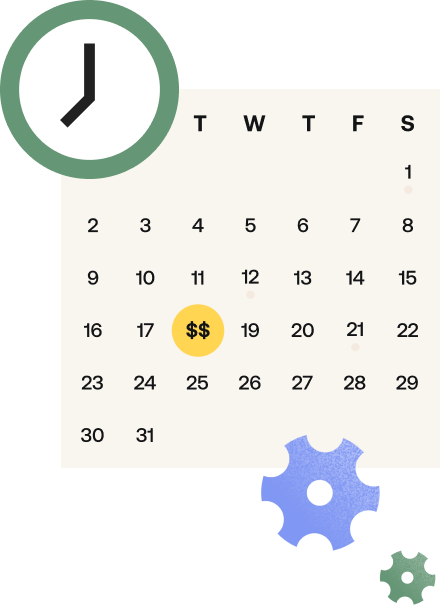Explore the art of timeboxing, its unique benefits, and practical strategies for implementing it in both individual and team settings to claim control over your time and achieve your goals efficiently.

Only 18% of people have a proper time management system in place, resulting in the average employee spending 51% of their workday on low to no-value tasks instead of focusing on what’s important. If you’re running a business, that won’t do for your or your team’s time. If you want increased business productivity, you must have a time management system.
Just 10 to 12 minutes of focused time to plan your day can save you up to two hours daily. So, if you want to keep your focus and reach your goals, embracing a time management technique is essential. Today, the technique you’ll learn about is timeboxing.
Jump to:
- What is timeboxing?
- Timeboxing vs. block scheduling
- How to use timeboxing at work
- How to use timeboxing with a team
- FAQs about timeboxing
- Pair timeboxing with tools for streamlined project management
What is timeboxing, and what are its benefits?
Timeboxing is when you define specific blocks of time, or “boxes,” to your tasks and activities. Instead of working on a task until it’s either finished or another one comes along, you set a fixed time limit for focused work. The idea is to work with focused intensity during that time, and when the timer goes off, you move on to the next task on your list.
Timeboxing offers the following unique benefits:
- Enhanced focus and concentration
- Improved task prioritization
- Accountability
- Better time awareness
- Measurable progress
Related Post
6 effective time management tips for leaders
Timeboxing vs. block scheduling
While these two time management techniques are sometimes referred to interchangeably and similarly involve allotting specific times for chosen tasks, timeboxing and block scheduling differ in several ways.
- Block scheduling focuses on a schedule, dictating the amount of time and the time of day for addressing a specific task.
- Block scheduling is great if you prefer structure and routine since it schedules when your daily activities happen.
- Timeboxing chooses the amount of time you’ll spend on a particular task but remains flexible with the time of day you’ll address each task.
- Timeboxing offers versatility in addressing tasks by allowing for shorter time boxes rather than extended time blocks.
Example of a day of block scheduling
| Time | Task |
| 9:00 – 11:00 | Answer emails |
| 11:00 – 12:00 | Staff meeting |
| 12:00 – 1:00 | Lunch |
| 1:00 – 4:00 | Client appointments |
| 4:00 – 5:00 | Marketing strategy session |
| 5:00 – 5:30 | Answer emails and wrap up administrative tasks |
| 5:30 – 6:00 | Plan tomorrow’s tasks |
Example of a day of timeboxing
| Time | Task |
| 2 hours | Answer emails |
| 1 hour | Check-in with staff for any updates |
| 1 hour | Lunch |
| 1 hour | Marketing strategy |
| 30 minutes | Plan tomorrow’s to-do list |
| 30 minutes | Administrative tasks |
| 3 hours | Client appointments from 1:00 – 4:00 |
Both timeboxing and block scheduling are effective methods for keeping you organized and focused. They’re also sometimes coupled with other time management strategies to customize how you create focused time to knock everything off your to-do list.
Pro tip
HoneyBook offers a scheduling tool that helps you manage client scheduling and save time.
How to use timeboxing at work
To implement timeboxing effectively at work, begin by identifying your tasks. Then, break down larger projects into manageable subtasks. For example, instead of having a single mission to create a marketing campaign, break it down into smaller tasks like these:
- Set marketing goals and dates for the campaign
- Create a profile of the campaign’s target audience
- Define brand and voice
- Brainstorm ideas for each marketing channel
- Write content for chosen marketing channels
- Organize everything into a comprehensive plan
By breaking everything down into smaller goals, you can timebox each step and focus your attention on manageable steps rather than trying to tackle the whole project in one massive box of time.
Once you’ve broken everything down into manageable tasks, prioritize them. Incorporating prioritization techniques, such as the Eisenhower Matrix, can help you define your most urgent tasks and those that can wait.
From there, set realistic blocks for each task and implement them into your weekly and daily schedules. A significant appeal of block scheduling is that it dedicates focused time toward work but remains flexible, so you don’t feel as though your day is entirely regimented.
Here are some tips to help with time management at work.
- Use a timer: Using a timer will help you focus because you won’t be distracted by checking the clock to see how much time you have left.
- Take time to reflect: Take a moment after each time box to reflect on how this approach affected your work compared to the past.
- Allow for breaks: Studies show that taking breaks while working helps to increase productivity. So, consider incorporating an additional time management technique to balance breaks with focused work, like the Pomodoro Technique.
- Make adjustments but be consistent: The key to knowing if something works for you is committing to it. Changing your routine may feel strange initially, but you have to be consistent and make adjustments to discover how it works best for you.
How to use timeboxing with a team
Like with your individual work, to use timeboxing with a team, you’ll begin by identifying projects that require collaboration. If this is your first time doing this, a short introduction to this time management technique will help everyone get on the same page and understand the process.
During your team meeting, collaboratively allocate boxes of time to each task, taking into account the complexity and urgency of each task when setting time limits. For example, say you have a team brainstorming session for marketing content on various social media channels. You set a goal of developing a viable content idea for each channel that’s cohesive and on-brand for your company. Your structure may look something like this:
| Total time: 2 hours | Overall goal: Cohesive marketing content ideas for Instagram Reels, TikTok, SEO blog, and Pinterest |
| 10 minutes | Introduction to time management |
| 10 minutes | Allocate boxes of time for each social media channel |
| 30 minutes | Personal brainstorming for each channel (i.e., employee #1 IG ideas, employee #2 SEO blog ideas, etc.) |
| 5 minutes | Break |
| 45 minutes | Sharing ideas and finding ways to make them cohesive |
| 5 minutes | Break |
| 15 minutes | Discussion on how the session went and adjustment ideas for next time |
As with using it individually, when using timeboxing as a team, it’s a good idea to use a timer to maintain focus while working. Additionally, you want to reflect, gather feedback, and discover possible adjustments to ensure your group sessions are as productive as possible.
FAQs about timeboxing
Aside from what timeboxing is and tips for how to implement it with your team, here are the answers to some other common questions you may have about timeboxing.
How do I choose the right duration for each timebox?
Timebox duration depends on the task’s complexity, your energy levels, and personal preferences. Generally, shorter timeboxes are ideal for routine tasks, while longer timeboxes match better with complex and creative work. Shorter timeboxes tend to be around 25 minutes, and longer timeboxes around an hour.
What should I do if a task isn’t completed within the allocated timebox?
If a task isn’t completed within the set timebox, you can adjust your schedule to allocate more time later or reschedule the task for another day. Assess why the task took longer than expected to make improvements.
How can I stay disciplined and avoid distractions during a timebox?
Minimize distractions by turning off notifications, using website blockers, and creating a designated workspace. Set clear intentions for each timebox, and consider using noise-canceling headphones or background music to maintain focus.
What tools or apps can help me with timeboxing?
To get the most out of timeboxing, you need to first understand how much time you spend on different tasks. To do so, you can use a simple timer, or use some type of time tracking app.
For instance, HoneyBook offers a time tracker that you can use in real-time or manually by adding your time logs. It can give you an accurate picture of how you and your team spend your time at work. Plus, you can use it for more accurate invoicing.
It’s also important to protect your time once you have a good structure set in stone. Use a meeting scheduler where you can block off your time and only offer availability during the hours you’ve already set aside for meetings and sessions.
With HoneyBook, you can set up your schedule so you’re only allowing clients to schedule meetings at certain times, and the same for leads scheduling discovery or consultation calls.

Use HoneyBook to manage client meetings and set the schedule that works best for you.




